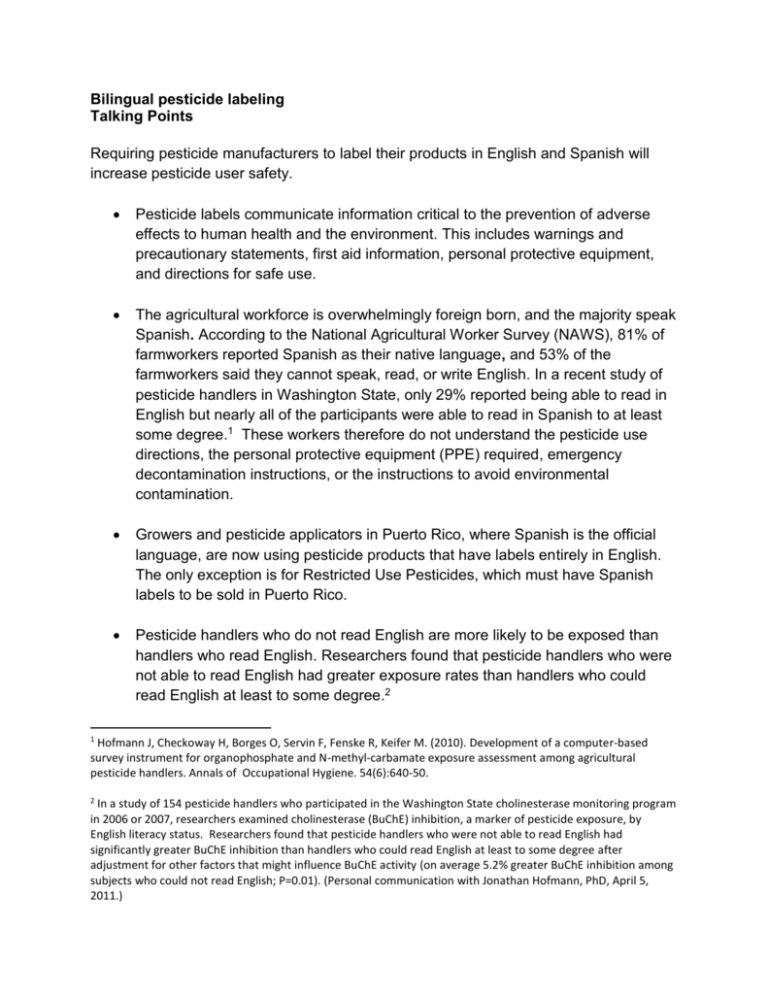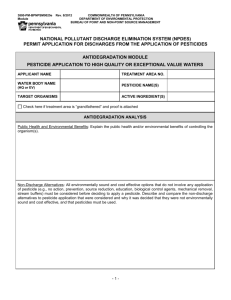Bilingual label talking points
advertisement

Bilingual pesticide labeling Talking Points Requiring pesticide manufacturers to label their products in English and Spanish will increase pesticide user safety. Pesticide labels communicate information critical to the prevention of adverse effects to human health and the environment. This includes warnings and precautionary statements, first aid information, personal protective equipment, and directions for safe use. The agricultural workforce is overwhelmingly foreign born, and the majority speak Spanish. According to the National Agricultural Worker Survey (NAWS), 81% of farmworkers reported Spanish as their native language, and 53% of the farmworkers said they cannot speak, read, or write English. In a recent study of pesticide handlers in Washington State, only 29% reported being able to read in English but nearly all of the participants were able to read in Spanish to at least some degree.1 These workers therefore do not understand the pesticide use directions, the personal protective equipment (PPE) required, emergency decontamination instructions, or the instructions to avoid environmental contamination. Growers and pesticide applicators in Puerto Rico, where Spanish is the official language, are now using pesticide products that have labels entirely in English. The only exception is for Restricted Use Pesticides, which must have Spanish labels to be sold in Puerto Rico. Pesticide handlers who do not read English are more likely to be exposed than handlers who read English. Researchers found that pesticide handlers who were not able to read English had greater exposure rates than handlers who could read English at least to some degree.2 1 Hofmann J, Checkoway H, Borges O, Servin F, Fenske R, Keifer M. (2010). Development of a computer-based survey instrument for organophosphate and N-methyl-carbamate exposure assessment among agricultural pesticide handlers. Annals of Occupational Hygiene. 54(6):640-50. 2 In a study of 154 pesticide handlers who participated in the Washington State cholinesterase monitoring program in 2006 or 2007, researchers examined cholinesterase (BuChE) inhibition, a marker of pesticide exposure, by English literacy status. Researchers found that pesticide handlers who were not able to read English had significantly greater BuChE inhibition than handlers who could read English at least to some degree after adjustment for other factors that might influence BuChE activity (on average 5.2% greater BuChE inhibition among subjects who could not read English; P=0.01). (Personal communication with Jonathan Hofmann, PhD, April 5, 2011.) Studies have shown that Latino farmworkers are disproportionately exposed to pesticides. Between 1998 and 2005, state and federal tracking systems identified 3,281 cases of acute occupational pesticide poisonings among farmworkers. Of these cases, 727 (22%) included information on the worker’s race or ethnicity. Of these 727 cases, 502 (69%) were Hispanic.3 Current regulations place a heavy burden on both workers and employers to provide their own translation. The following statement appears buried in the labels of the two most toxic categories of pesticides: “Si Usted no entiende la etiqueta, busque a alguien para que se la explique a Usted en detalle. [If you do not understand the label, find someone to explain it to you in detail.]” 40 CFR 156.206(e) Farmworkers and their family members are disproportionately exposed to pesticides and suffer adverse health effects. Costs to pesticide manufacturers would be small compared to the benefits to workers, their families, rural communities and the environment. Translation, printing, packaging, and other costs of complying with bilingual labeling requirements will not add significantly to manufacturing costs or prices to customers. Manufacturers of pesticides routinely translate their labels into Spanish as well as many other languages in order to sell them worldwide. Restricted use pesticides (RUPs) sold in Puerto Rico already have Spanish-language labels. Submitting Comments: 3 Comments are being accepted by EPA until June 28, 2011 via www.regulations.gov for EPA-HQ-OPP-2011-0014. The direct link is: http://www.regulations.gov/#!searchResults;rpp=50;po=0;s=EPA-HQ-OPP-20110014 Calvert GM, Karnik J, Mehler L, Beckman J, Morrissey B, Sievert J, Barrett R, Lackovic M, Mabee L, Schwartz A, Mitchell Y, Moraga-McHaley S. Acute pesticide poisoning among agricultural workers in the United status, 1998– 2005. Am J Ind Med. 2008;51(12):883–898.







